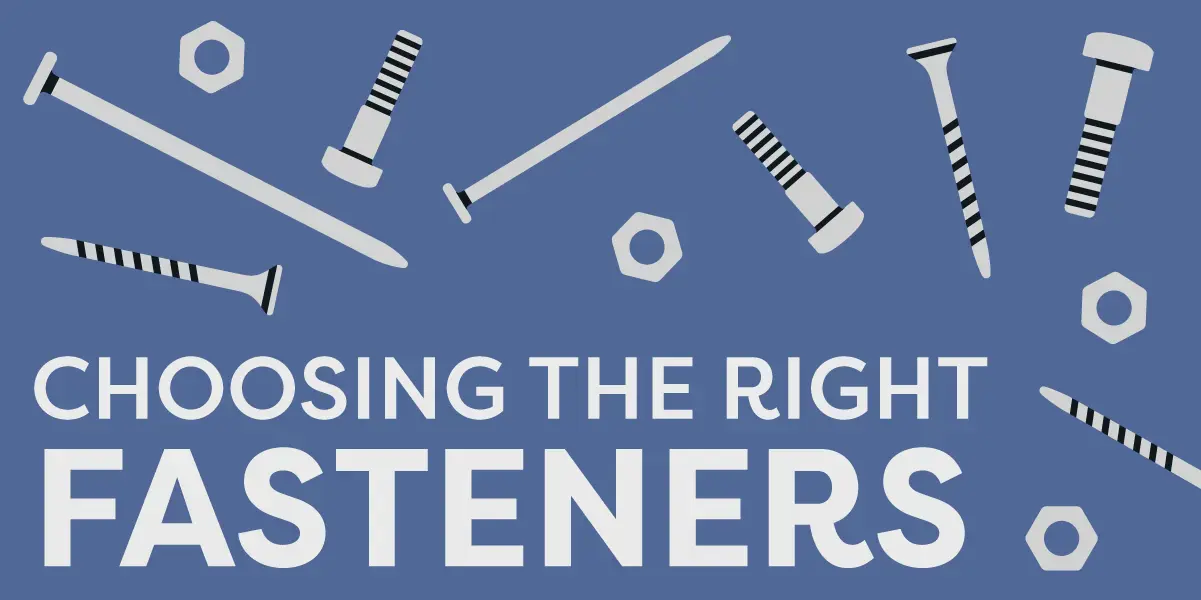Fasteners hold everything together, from towering skyscrapers to humble DIY projects.
Although hundreds of types and styles exist, the most common fasteners are nails, screws, bolts, and rivets.
Each type has unique characteristics and uses. Are you choosing the right fasteners for the projects around your home? Did you nail the last project, or did you screw it up?
Nails: The First Fasteners
The earliest recorded wrought iron nails date back to Egypt, around 3400 BC. They were used to build wooden structures and fasten metal to wood.
Although they’ve evolved over the centuries, their basic design remains the same: a sharp point at one end and a flat head on the other. They come in various sizes, materials, and head shapes for different applications.
Nails are ideal for securing lightweight materials like wood, drywall, or fabric. Unlike bolts, rivets, and some screws, they don’t need pre-drilled holes.
However, they have comparatively little holding power and are prone to bending or popping out. They’re unsuitable for heavy-duty applications or materials requiring a solid grip.
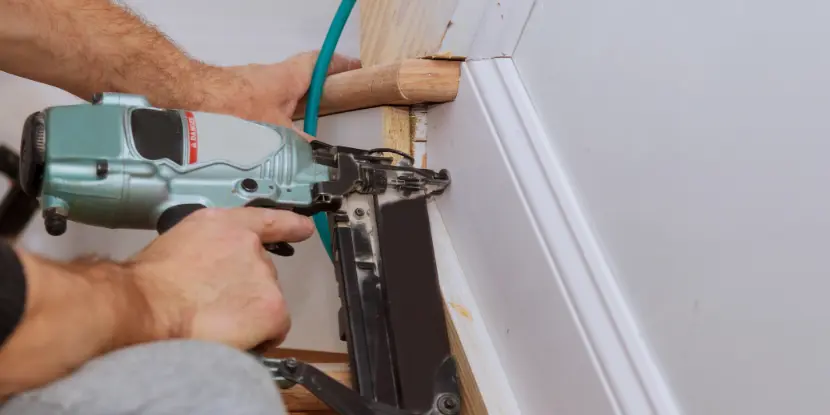
Attaching trim to a wall with a power nailer.
Types of Nails
- Common nails for general construction
- Finish nails for applications where appearance matters
- Roofing nails, made to withstand outdoor conditions
- Upholstery nails for furniture and upholstery
- Masonry nails, suitable for concrete, brick, or mortar
Best Applications for Nails
- Hanging picture frames and artwork
- Building lightweight structures like birdhouses or small sheds
- Installing baseboards, trim, and other decorative elements
- Upholstering furniture or attaching fabric to walls
- Joining masonry or concrete materials
Screws: The Most Versatile Fasteners
The first recorded wooden screw was invented by Archytas of Tarentum in ancient Greece around 400 BC. It wasn’t until the 1700s that metal screws became more common, thanks to the introduction of the screw-cutting lathe.
A screw’s spiral design provides a firmer grip than nails, making it a better choice for heavier loads. Unlike nails, screws need pre-drilled holes to prevent wood from splitting or cracking when they’re driven in.
Pre-drilling also creates a guide for the screw to follow, ensuring a more precise placement and reducing the chances of the screw getting stuck or breaking off.
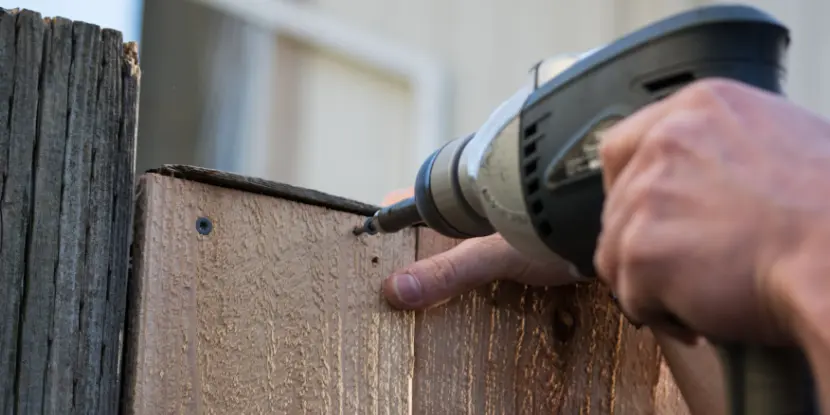
Driving a screw with a power drill.
Types of Screws
- Wood screws for wood or other soft materials
- Sheet metal screws, made for attaching metal sheets, gutters, and flashing
- Machine screws, used with nuts and bolts for more secure fastening
- Drywall screws designed specifically for drywall installation
- Concrete screws for masonry and concrete materials
- Machine screws, used in precision applications with threaded nuts or tapped holes
- Concrete screws for concrete or masonry surfaces
- Self-drilling screws — these have a drill-like point for piercing through metal
Best Applications for Screws
- Building furniture, cabinets, or other wooden structures
- Installing metal roofing or gutters
- Assembling electronics or machinery with nuts and bolts
- Hanging shelves, mirrors, or other heavy items
- Installing drywall, plasterboard, or other sheet materials
- Attaching fixtures or accessories to concrete or masonry surfaces
Bolts: The Heavy-Duty Fasteners
Bolts are similar to screws, but with one key difference: they have a blunt end instead of a pointed one. They’re usually larger and thicker than screws, making them ideal for heavy-duty applications requiring high strength and torque.
Like screws, bolts need pre-drilled holes and use nuts to secure them in place. They come in various materials, such as steel, stainless steel, or titanium, for different levels of strength and corrosion resistance.
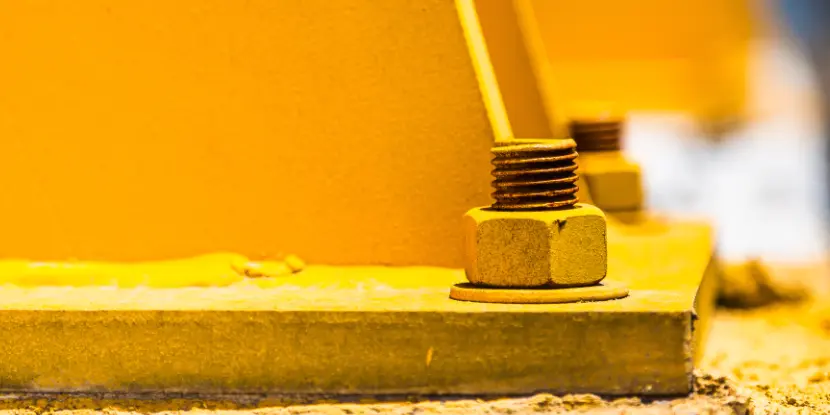
Heavy-duty bolts holding metal construction to the floor.
Types of Bolts
- Hex bolts — the most common type with a hexagonal head
- Carriage bolts, also known as coach bolts, have a smooth, round head and a square shank
- U-bolts, shaped like the letter U, used for attaching pipes or tubes to surfaces
- Eye bolts — have a loop at one end for attaching ropes or cables
- Lag bolts — large, heavy-duty screws for securing wood to surfaces
Best Applications for Bolts
- Building structures like bridges or outdoor decks
- Installing heavy machinery or equipment
- Securing wooden posts or beams in construction
- Assembling furniture with metal parts and joints
- Attaching or anchoring pipes, cables, or wires
Rivets: The Ancient Fasteners
Rivets date back to ancient civilizations like the Romans and Egyptians. They were used in large-scale construction projects and shipbuilding, where holding heavy materials together was crucial.
These babies don’t require a second piece like a nut to secure them in place. They’re inserted through pre-drilled holes, and then flattened or deformed at the end to create a strong bond.
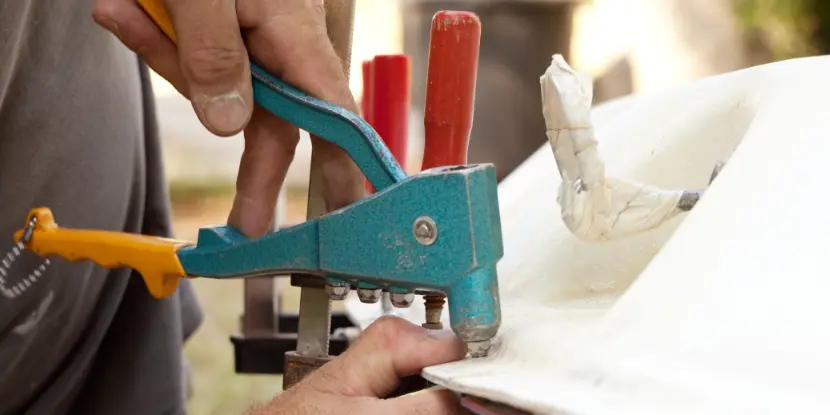
Using a riveter to attach fiberglass.
Types of Rivets
- Solid rivets — the original type, made from one solid piece of metal; require special tools for installation and removal
- Blind rivets, also known as pop rivets, have a mandrel that breaks off after installation
- Drive rivets — similar to solid rivets, but can be installed without specialized tools
- Tubular rivets — used for joining thin materials like leather or textile
Best Applications for Rivets
- Shipbuilding, automotive, and aerospace industries
- Securing metal sheets together in construction or roofing
- Joining pieces of thin material like fabric or leather
- Assembling furniture or other wooden structures without visible fasteners
- Large-scale construction projects like bridges, ships, or aircraft
- Joining metal sheets or panels in automobiles or appliances
- Attaching metal hardware or accessories to clothing or accessories.
Factors to Consider When Choosing Fasteners
- Material Compatibility: The fastener should be compatible with the joined materials to prevent corrosion or structural issues.
- Load-Bearing Capacity: Consider the forces the fastener will endure and select one with adequate strength.
- Environmental Factors: Moisture, temperature fluctuations, and chemical exposure may affect the fastener’s performance.
- Installation Difficulty: Some fasteners require special tools or skills.
- Aesthetics: If you care about appearance, choose fasteners that are less visible and can be concealed for a more polished look.
- Durability & Longevity: The fasteners should withstand wear and tear over time.
FAQs: All About Fasteners
Q: What’s the difference between a screw and a bolt?
A screw has a pointed end to bore into materials. A bolt is used with a nut and often has a blunt end, requiring a pre-drilled hole.
Q: How do I choose the right size fastener?
The right size depends on the materials being joined and the load they’ll bear. Generally, the material’s thickness and the load type (tensile or shear) will determine the diameter and length of the fastener you need.
Q: Can I reuse bolts and screws?
Sometimes. Inspect them for signs of wear, damage, or stretching. In critical applications, we recommend new fasteners to ensure the integrity of the connection.
Q: What types of screws are best for wood?
Wood screws are explicitly designed for wood, offering sharp threads that cut into the wood and provide a strong hold. Choosing the right length and diameter prevents the wood from splitting.
Q: Which fasteners are waterproof?
Fasteners made from stainless steel or aluminum and coated with zinc or chrome are water-resistant and less likely to corrode, making them suitable for outdoor or marine environments.
Q: What’s the best way to prevent fasteners from loosening?
Lock nuts, spring washers, or thread-locking fluid can prevent fasteners from loosening due to vibration or dynamic loads.
Q: How can I remove a broken or stripped screw?
Specialized tools like screw extractors or left-handed drill bits can remove broken or stripped screws. Sometimes, applying heat or a penetrating oil can ease removal.
Q: What’s a torque specification, and why does it matter?
Torque specification refers to the amount of force to tighten a fastener. It’s important to ensure the fastener is neither too loose (which could lead to detachment) nor too tight (which could strip the threads or break the fastener).
Q: Can I use screws in plastic?
There are special self-tapping screws designed for plastic, but choose the right size and avoid over-tightening, which could damage the plastic. Bolts or rivets may be a better option for joining plastic pieces.
Q: What’s the best way to drill a pilot hole?
Use a drill bit slightly smaller than the diameter of the fastener to ensure a snug fit without splitting the material.
Q: Why do some screws have different head shapes?
Different head shapes serve different purposes. Flat or countersunk heads lie flush with the surface for a smoother appearance, while round or pan heads protrude from the surface and provide more grip when tightened. The right head shape also depends on the type of load and materials being joined.
Q: How do I know if a fastener is high quality?
High-quality fasteners have certifications or grades indicating their material properties, manufacturing standards, and suitable applications. Look for fasteners that meet industry standards or have been tested for specific loads.

